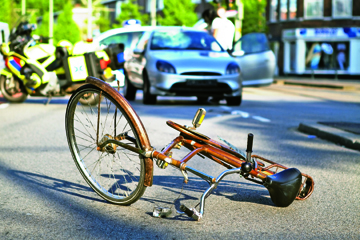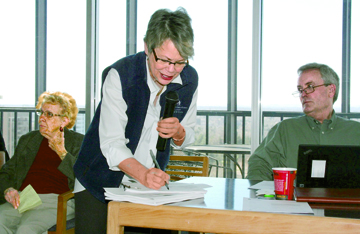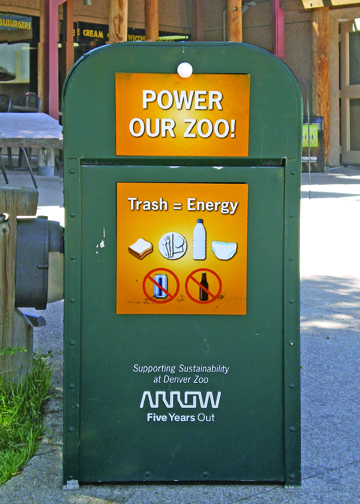
by Mark Smiley | Aug 31, 2015 | Main Articles
A Plea For A Bicycle-Friendly Denver
by Phil Kummer
 After a slow start to the biking season, due to very wet weather, bikers are being seen more and more in Denver and throughout the Metro area. As you ride around and talk with fellow bikers you can’t help but notice that bikers, bike routes and bike transport are treated as second-class, second-rate citizens in Denver and the surrounding area.
After a slow start to the biking season, due to very wet weather, bikers are being seen more and more in Denver and throughout the Metro area. As you ride around and talk with fellow bikers you can’t help but notice that bikers, bike routes and bike transport are treated as second-class, second-rate citizens in Denver and the surrounding area.
Recently radio personality Mike Rosen wrote a column for The Denver Post about the comments of Denver City Council members Mary Beth Susman and Albus Brooks who propose to discourage driving in Denver and make it more convenient for bikers. He states that “bicyclists are junior partners” when it comes to transportation in Denver. Most bikers, though, would say that bike transport is barely a partner and more like a “Johnny come lately” and not given its due in the transportation scheme of things.
Bicycles are the transportation stepchild that nobody wants to commit to yet but are necessary to acknowledge because there are, and will be, more issues with moving a lot of people through cities. Rosen’s point that the primary purpose of a road system is “to move a high volume of traffic and people quick ly and efficiently…” is partially correct. It fails though to consider issues such as car/bicycle crashes, freedom of mobility, parking, congestion, costs involved in maintaining a street for an automobile vs. a bicycle, air pollution, pedestrian safety, safety in general and neighborhoods.
ly and efficiently…” is partially correct. It fails though to consider issues such as car/bicycle crashes, freedom of mobility, parking, congestion, costs involved in maintaining a street for an automobile vs. a bicycle, air pollution, pedestrian safety, safety in general and neighborhoods.
As far as being efficient, it seems odd that one would consider commuting by a vehicle with generally one occupant, the driver, and having 25 percent occupancy as being efficient. Rosen’s article is a celebration of mindlessness and dogma that has 20/20 vision concerning what has worked for the past 60 years but has nothing to offer that might address the above issues.
The perception that bike transport is an unwanted stepchild is reinforced by the recent auditor’s report that shows a serious underfunding of the Denver Moves plan. Denver Moves is a citywide plan approved in 2011 that “expands the vision for the non-motorized transportation and recreation system in Denver.” Denver Bikes and the Mayor’s Bicycle Advisory Committee are both doing yeoman’s work as far as promoting and overseeing the construction of bike friendly infrastructure as specified by Denver Moves, yet it seems an uphill battle.
The plan “focuses on integrating the existing off-street and on-street networks to create safe, comfortable corridors that link neighborhoods, parks, employment centers, business districts, transit hubs … in all parts of Denver.” Unfortunately, since 2013, the city has dedicated only $2.8 million for bike lanes and pedestrian-oriented projects from the capital improvements budget, a tiny fraction of the estimated overall cost of $119 million.
Although budget concerns are important, the bigger picture concerning bike transport is how to retrofit an entire city to produce a safe, convenient, efficient and effective way to travel that will be used by the multitudes. Denver, as most cities, is trying to fit a bike system into a preexisting system designed for cars, trucks and motorcycles so no matter how much sense it makes to promote bikes and other alternative modes of transportation it will always be difficult to retrofit a 60-year-old system to meet new and different transport goals.
Even though Vincent Carroll in a recent Denver Post column, sees this effort by the city as “a methodical, long-term effort to frustrate the use of the personal auto,” it is actually an effort to counteract the years  of neglect and disrespect that bike transport has suffered by a society that is in love with motor vehicles. Our government, Federal, State and local, has long supported low density housing and the transport systems designed for that lifestyle. In the marketplace of transport alternatives we’ve been given one realistic choice — get a car and be happy.
of neglect and disrespect that bike transport has suffered by a society that is in love with motor vehicles. Our government, Federal, State and local, has long supported low density housing and the transport systems designed for that lifestyle. In the marketplace of transport alternatives we’ve been given one realistic choice — get a car and be happy.
In planning to retrofit a bike system the biggest factor is safety and how comfortable riders feel on the road or bikeway. In 2013, Michael Andersen of People for Bikes in his article “Selling Biking: Perceived Safety, The Barrier That Still Matters,” cited studies and surveys in Portland and San Francisco that indicate the vast majority of cyclists are concerned for their safety while on the road, and they especially feared a collision with an auto. On a national level 743 cyclists were killed and about 48,000 were injured in motor vehicle traffic crashes in 2013. The average age for those killed is 44 and of those injured the average is 32 so it would seem that is not a young and reckless group. Colorado suffered 12 biker fatalities in 2013.
Bike to Work Day, an event promoted by Bike Denver and the Mayor’s Bike Advisory Committee, was held June 24 and drew approximately 32,800 bikers who rode an average of 9.2 miles one way to work. On a daily basis Denver has generally fewer than 7,000 bike commuters or about 2 percent of the total number of commuters. Although this is a small number, it is actually very significant given the difficulties and dangers that bikers have to put up with while riding on Denver streets.
This suggests that if Denver streets were actually biker friendly we could reduce the number of vehicles and congestion, make parking easier and spend less money on road maintenance. But the bigger question for the biking community is, “how do we make biking a general form of transportation and not just for a small number of hard core bikers?” Mobility freedom then should be promoted for all Denver citizens not just those who have a motor vehicle or who brave the mean streets on a bike.
An interesting solution to mobility freedom was highlighted in the April 2015 Glendale Cherry Creek Chronicle in a front page article by Heather Brecl, “The Sunny Side to An Eco-Friendly Revolution: the ELF.” The article describes a new, high tech vehicle that is powered by both the rider with pedals and a solar powered motor. Neither Bike Denver nor the Mayor’s Bicycle Advisory Committee have addressed new technologies such as three- or four-wheeled bicycles that are part human powered and part motor driven. The ELF, which is 9 feet long, over 4 feet wide and 5 feet tall, is larger than your standard two-wheeled bike. It is attractive as a commuter vehicle but there does not seem to be a place for it on Denver streets. This type of vehicle, which is technically a bike, has the potential to be a transportation game changer but will there be a place where the multitudes can use a vehicle such as this?
One solution that has yet to be discussed is to have bike only streets that welcome a variety of human powered or combo-powered bikes. A few strategic, long streets in Denver could be selected that would lend themselves to a different type of commuting and biking experience. Only then, will we as a city be able to say that we did our best to solve the transportation and parking issues that dog us every day.

by Mark Smiley | Aug 31, 2015 | Main Articles
Part II Of City’s Attack On Its Own Neighborhoods?
by Glen Richardson
 Denver has been known for its highly livable neighborhoods which contain more single family homes than almost any comparable city in the United States. But single family homes have been deemed by some progressive urbanists as a villain in the fight against urban sprawl and the cause of much hated suburbia.
Denver has been known for its highly livable neighborhoods which contain more single family homes than almost any comparable city in the United States. But single family homes have been deemed by some progressive urbanists as a villain in the fight against urban sprawl and the cause of much hated suburbia.
There has been a call for ever more density in Denver by individuals such as Denver Planning Executive Director Brad Buchanan (who lives on a 1,500 acre ranch outside of Denver) and former councilman and failed auditor candidate Chris Nevitt. Nevitt demanded in a speech explaining why he was voting for high density rezoning of Mount Gilead Church property that every neighborhood in Denver must do its share to absorb high density. His views were condemned by neighborhood groups and even by The Denver Post in a scathing editorial. But his views are believed to be supported by a significant majority on the Denver City Council.
 But building high-rise apartments on former park and church land has been deemed by Nevitt and others as not sufficient to destroy the single family neighborhood character of neighborhoods like Washington Park, Hilltop, Crestmoor, Congress Park and Cherry Creek North. Thus some members of the Denver City Council have turned to doing away with concept of “single family” homes at all. By pushing the idea of “short-term rentals” where every former single family home can be turned into a mini apartment house, high density can also be obtained.
But building high-rise apartments on former park and church land has been deemed by Nevitt and others as not sufficient to destroy the single family neighborhood character of neighborhoods like Washington Park, Hilltop, Crestmoor, Congress Park and Cherry Creek North. Thus some members of the Denver City Council have turned to doing away with concept of “single family” homes at all. By pushing the idea of “short-term rentals” where every former single family home can be turned into a mini apartment house, high density can also be obtained.
What were once sleepy streets throughout the city are suddenly waking up to the fact that the Valley’s homes-as-lodging trend is growing fast albeit not without controversy.
Neighborhood advocates say the trend is creating parking, trash and noise issues plus in a few instances disruptive or illegal activities. Furthermore, they argue these rentals detract from the peaceful and quiet enjoyment of neighborhood homes and property.
Despite currently being illegal (City’s Zoning Code requires month-to-month or longer tenancy), Denver’s short-term rental market is among the hottest in the nation. Airbnb alone has 1,000 Denver properties listed, according to Denver City Councilwoman Mary Beth Susman, the Council’s task-force chair. In fact Zillow — the online real estate database company — ranks Denver fifth among the country’s 50 top markets. Zillow also puts Denver as the eighth most expensive rental market in the U.S. and the most expensive between the two coasts.
Tech, Money Driven
Technology startups have emerged to encourage home rentals and host short-term retail platforms such as Airbnb, VRB O, HomeAway and others. These new and suddenly proliferating hospitality services are helping propel local property owners into the home rental business by providing hotel-type services from simple key exchanges to full rental management. A startup — known as the Key Exchange — gives homeowners the opportunity to store their property keys at a neighborhood restaurant and be notified when they are picked up or dropped off by renters.
O, HomeAway and others. These new and suddenly proliferating hospitality services are helping propel local property owners into the home rental business by providing hotel-type services from simple key exchanges to full rental management. A startup — known as the Key Exchange — gives homeowners the opportunity to store their property keys at a neighborhood restaurant and be notified when they are picked up or dropped off by renters.
Pillow — a full-service online short-term rental service — handles listings and price optimization, bookings, guest screening and communications, key exchange plus laundry. Currently, it works with Airbnb, VRBO and HomeAway. Pillow recently raised $2.65 million and is planning to expand its full service into 10 U.S. cities.
A key reason short-term rentals are becoming common is because these renters are paying top dollar. Furthermore, more money can often be made by renting homes to tourists for a few days at a time compared to renting to local families on a monthly or yearly basis. Additionally, a new type of property buyer is entering the local housing market exploiting the sudden popularity of short-term rentals with an eye on quick profits. A Florida firm, for example, recently purchased a Capitol Hill building and is renting all of the units on a short-term basis, upsetting local residents. Finally, a growing number of tourists are seeking vacation destinations that offer something more than simply a hotel room.
Grappling Wit h Issues
h Issues
Issues regarding short-term rentals are coming to a head in Valley neighborhoods plus the Denver City Council is looking at length at the issues. What they are finding out is that there are a lot of problems. Recognizing that vacation rentals are not a passing trend, nearly every Valley neighborhood is grappling with regulations to help mitigate their impact.
Neighborhood organization INC — the Inter-Neighborhood Cooperation — has passed a resolution urging both the Denver City Council and Mayor Michael Hancock to enforce the provisions of the Denver Zoning Code prohibiting short-term rentals. The organization is also calling for a range of regulations that would include taxation, licensing and limitations based on density and location.
When the City Council’s Shared Economy Task Force began studying short-term rentals, resident George Mayl asked, “Why on such an important citywide topic have the meetings by Councilwoman Susman not been televised?” This April her Task Force became part of the Council’s Neighborhood & Planning Committee and is now televised on the fourth Wednesday of each month. Mayl told the Chronicle, “It is time for the City to protect its residential neighborhoods from commercial encroachment.” He observes that more and more cease and desist orders are being brought to Board of Adjustment hearings as residents learn they do not have to put up with motel type activities in their neighborhoods.
Close To Home
Short-term rentals drew special interest from attendees at the West Wash Park Neighborhood Assn. (WWPNA) meeting on April 22. The attention was due to the fact a neighborhood home owned by a Florida investor was listing the home for rent as cannabis-friendly. The owner withdrew her appeal of a cease and desist order after her properties in Congress Park were closed down.
“The members at this meeting were quite concerned that these short-term rentals can be disruptive, the lodging taxes aren’t paid, they remove housing — particularly affordable housing — from an already squeezed market and violate the zoning code and commercialize residential zoning,” resident Charlotte Winzenburg tells the Chronicle.
She adds that when the Denver Zoning Code was being re-written, “WWPNA was an active participant in all the public meetings and had an ad hoc committee that spent many hours over many months studying the proposed code, commenting on proposals and lobbying for the zoning that our neighbors told us they wanted.”
Neighborhood Risks
The INC Zoning & Planning Committee known as ZAP has analyzed the potential impact to Denver’s neighborhoods and identified significant risks. “Our assessment includes the effect it will have on affordable housing, key enforcement agencies and Denver governmental departments. The Committee has grave concerns about the real possibilities of unforeseen and unintended consequences of permitting short-term rentals in residential neighborhoods. This is not a problem for another day. The decisions we make today will determine the future of Denver’s neighborhoods,” says the ZAP Committee co-chaired by Margie Valdez and Greg Kerwin.
Among the issues Denver City Council must address is the argument by proponents that private property rights must be protected. Advocates also contend regulations could harm the economy. Furthermore, if regulations are adopted, how many short-term rentals should be allowed in a neighborhood and how would the number be determined? Should registration and/or licensing be required in order to provide notice to neighborhoods (needs and desires hearings)?
The City must also consider what new City Ordinances should be required for short-term rentals. Possibilities include public nuisance, noise limits, property maintenance standards and nighttime curfews. Other considerations include parking restrictions, inspections, and emergency access. Finally, will new trespassing and disturbing the peace regulations be necessary?
What’s At Stake?
INC estimates that any change to regulations that would allow short-term rentals could result in 10,000 or even 20,000 or more added neighborhood rentals to Denver. “How many of these will be in violation of what change might be made to the zoning code?” the organization asks. Another question: “How will Denver’s Neighborhood Inspection Services possibly be able to monitor a greater number than they currently cannot monitor, particularly when other cities have been unable to do so?”
Lenders and insurers of properties must be included as stakeholders to ensure loan and insurance documents are in compliance, INC believes. Homeowners insurance, they note, does not include short-term rental damages. They also worry that a lack of premise health and safety inspection would endanger visitors and tourists.
Turning neighborhoods into areas for motels and hotels destroys the integrity of the neighborhood and, more importantly, the expectations of the property owners who purchased the property with the intention of a neighborhood remaining a residential neighborhood, INC says. Wrapping up, the citywide advocate representing Denver neighborhood association members concludes: “This is a city we call home. Is City Council propounding legislation that benefits a few residents and shared economy entrepreneurs-opportunists at the expense to the quality of life of most Denver residents? We hope not.”

by Mark Smiley | Aug 31, 2015 | Glendale City News
by Marco Cummings
Writer for and on behalf of the City of Glendale

GLENDALE, CO – AUGUST 16: Denver vs Serevi Selects during the Serevi RugbyTown 7s tournament at Infinity Park in Glendale, Colorado on August 16, 2015. (Photo by Seth McConnell)
In his nearly two decades of playing the game of rugby, Fiji international Waisale Serevi became known around the globe as the “King of Sevens” for his prowess in the fast paced, seven-a-side version of the game.
Therefore, it’s fittingly appropriate that the tournament which bears his namesake, the Serevi RugbyTown Sevens (SRS) has become the crown jewel of sevens tournaments in North America.
For the fourth-straight year, Glendale, Colorado, the city that’s become synonymous with the moniker RugbyTown USA, hosted the three-day event (Aug. 14-16) and with 17 teams from around the world once again competing for a $10,000 cash purse, the event proved to be as enticing as ever for players and fans alike.
“This is all we’ve waited for. This is as good as it gets in North America and it’s some of the best rugby around the globe,” Glendale Mayor Mike Dunafon said of this year’s competition. “It’s what makes the Serevi RugbyTown Sevens such an important tournament. It is the essence of the future of the game of rugby.”
Following a disappointing campaign in which the Raptors fell short of their goal of qualification for this year’s Men’s Club 7s Nationals, the local club entered the tournament with something to prove not only to fans and opponents, but to themselves. By the weekend’s end, the team felt they had proved their point, stringing together competitive showings and results en-route to a fourth place finish in the field of 17.
“It was a great show of character. For us to be a local club side and to take fourth place, I’m happy with that,” Glendale Raptors head coach Andre Snyman said. “We’re disappointed but holding our heads high. I’m very proud of them for the way we played.”
It was a quarterfinal loss to eventual tournament champions and crosstown rivals, the Denver 7s, on the final day of the tournament which would derail the Raptors’ chances to win this year’s SRS Cup and the prize money that went with it.
Denver defeated a team which also bore the Serevi name, the Serevi Selects, 28-24 in an exciting final match, which proved to be an emotional win for Denver captain Maximo DeAchaval.
“We stuck together, we played together, and we finished together. We did everything together. My boys did it,” Denver captain Maximo DeAchaval said postgame. “[Serevi Selects] have great players and are great guys. We love playing them, hate playing them but it’s always a pleasure. We’re pretty happy.”
This year’s edition of the tournament also featured a new element. An inaugural high school tournament alongside the senior action, with the Glendale Raptors U-18s competing for the first time with seven other junior teams. The junior Raptors fared decently, with three wins and 12 points in the table. But it was visitors Atlantis who would win the High School Championship, defeating the Utah Lions 31-26 in the final.
Opportunities to watch local rugby sides compete against all-star and select sides from around the country and international locals wasn’t the only draw for fans to come out to Infinity Park. The Military Championship, which pits teams from each branch of the U.S. Military, has always been a fan favorite and staple of SRS.
Teams from each branch of the armed forces competed for positioning in Pool A, and after Day 1 of the tournament, Army and Air Force rose to the top. On Day 2, Army would defeat Air Force twice, 22-12 to win the pool and 43-12 to win the Military Final, marking the Black Knight’s third Military Championship in the four years of the tournament.
“It’s definitely our goal to win the Armed Forces Championship. Every year it’s a new team and a new competition so it’s just about 12 guys coming together as part of the All-Army family and getting the result that we wanted,” said Army team captain Andrew Locke.
The awards didn’t stop there. In addition to the SRS Cup, $10,000 purse, High School and Military Championships, teams also fought for the SRS Plate, Bowl and Shield awards.
Northeast Academy defeated Negro Y Azul 26-19 to win the Plate. Atlantis surprised the USA Collegiate All-Americans to win the Bowl by a score of 22-17. In the Shield Final, dark horse Bermuda also put on a show to beat Mexico Serpientes by a score of 19-15.
“It’s wonderful to have this kind of talent brought together for us to play against,” Atlantis coach Chris Ryan said. “The tournament is fantastic.”
That particular match was one  for seventh place in the tournament, but it was a true indication of the field’s quality from top to bottom, pitting the tournament newcomers against the 2013 SRS Champions.
for seventh place in the tournament, but it was a true indication of the field’s quality from top to bottom, pitting the tournament newcomers against the 2013 SRS Champions.
“When you play a group like that, you’re playing the best of the best,” Ryan said of the All-Americans. “There’s a lot of future USA Eagles in that group and it was an honor to play against them.”
And with the competition becoming better and better each year, the anticipation will only grow stronger in the coming months while fans of rugby in North America anxiously await the fifth edition of the Serevi RugbyTown Sevens.

by Mark Smiley | Aug 31, 2015 | Travel
by Josh Schlossberg
The Denver Zoo is more than halfway through the construction of a first-of-its-kind energy facility to be fueled by elephant manure and trash — including plastic and food scraps — that would provide 20 percent of the Zoo’s electricity, and heat its elephant exhibit.
The self-described “greenest  zoo in the country” is framing its plan to convert millions of pounds of annual waste into an alternative fuel source as an environmental leap forward that will help it achieve its goal of Zero Waste by 2025.
zoo in the country” is framing its plan to convert millions of pounds of annual waste into an alternative fuel source as an environmental leap forward that will help it achieve its goal of Zero Waste by 2025.
Critics, however, including local residents, the Rocky Mountain Chapter of the Sierra Club, the former director of the American Environmental Health Studies Project, and a U.S. Environmental Protection Agency (EPA) scientist, voice concerns ranging from air pollution, undermining of recycling and composting efforts, and environmental justice issues.
The Denver Zoo declined requests by this reporter for a tour, interview, or statement for this article.
Green Light For Green Energy?
The Zoo’s “biomass gasification system” has been 10 years in the making, developed by Zoo staff in partnership with the City and County of Denver, National Renewable Energy Labs, Colorado Department of Public Health and Environment (CDPHE), Colorado School of Mines, and University of Colorado.
The facility, which is 50 to 75 percent installed, according to minutes from a June 3, 2015, Denver Zoological Foundation meeting, is located in the Toyota Elephant Passage Exhibit on the Zoo’s southern boundary, adjacent to Duck Lake in City Park.
The project has undergone technical review by CDPHE and the City Council, received its construction permit, and is awaiting approval for an air permit. The State also issued water quality and sewer use permits, though a wastewater permit will not be granted until the facility is operational and liquid waste can be analyzed for potential contaminants.
Fuel To The Fire
The Denver Zoo gasifier will source its fuel from 750,000 pounds of elephant dung per year, along with 3 million pounds of waste from the zoo and outside sources, including: wood chips, food waste, waste paper, biodegradable plastic, non-biodegradable plastic, aluminum and other metals, according to a June 20, 2013, email exchange between EPA and CDPHE. Denver Zoological Foundation minutes state that fuel will be “87-89% biomass depending on the season.”
The materials will be shredded, dried, and converted into pellets and exposed to high temperatures in a low-oxygen environment to create a combustible synthetic gas (syngas), that will be mixed with natural gas to power generators, supplying 20% of the Zoo’s electricity. The leftover heat will run through pipes to heat the Toyota Elephant Passage Exhibit.
The facility is permitted as a controlled partial combustion system, with some aspects of the technology kept from the public as trade secrets. Trash and biomass gasifiers are still in the experimental stages and “not yet proven in commercial applications,” according to the National Renewable Energy Labs.
While the Zoo has avoided the use of the term incinerator, the EPA-funded Combustion Portal defines an OSWI (Other Solid Waste Incinerator) as “incinerators that due to their small size or other characteristics are not covered under other incinerator air emissions regulations.” The Zoo’s Engineering Design and Operations Plan (EDOP) states that the Zoo will follow the OSWI requirements, while referring to the “incineration (thermal conversion) of waste material.”
Solid Waste Incinerator) as “incinerators that due to their small size or other characteristics are not covered under other incinerator air emissions regulations.” The Zoo’s Engineering Design and Operations Plan (EDOP) states that the Zoo will follow the OSWI requirements, while referring to the “incineration (thermal conversion) of waste material.”
The construction permit issued by CDPHE explains that the facility will utilize a thermal oxidizer — which the EPA refers to as a thermal incinerator — for start up and shut down, where excess gas will be combusted in a flare.
Zoo staff will remove tars that build up in the scrubber and send them through the gasifier. Up to 60,000 pounds of ash per year will be a byproduct of operations, which will be landfilled.
The Solution To Pollution
The facility’s potential impact on local air quality and effects on public health is the main concern of neighbors.
According to the construction permit, the facility can emit up to the following levels of air pollutants per year: 6.3 tons of particulate matter (PM), 6.3 tons of PM 10, 6.3 tons of PM 2.5, (which can cause lung disease), 14.6 tons of Nitrogen Oxides (respiratory problems), 0.22 tons of Sulfur Dioxide (respiratory), 9.3 tons of Volatile Organic Compounds (which are carcinogenic), and 31.8 tons of Carbon Monoxide (reduces oxygen to heart, brain, and tissues).
The Zoo will also emit small amounts of dioxins, which, according to the EPA, are “highly toxic and can cause cancer, reproductive and development problems, damage to the immune system, and can interfere with hormones.”
Paul Connett, PhD, former director of the American Environmental Health Studies Project and author of the book Zero Waste Solution, spoke at the Ford-Warren Branch of Denver Public Library on July 30 about the health and environmental impacts of trash incineration and gasification.
“You should not be conducting such experiments in a residential area or near exotic animals that may be super sensitive to some of the air pollutants,” said Connett of the Zoo’s gasifier. “This project can only be considered an ongoing experiment.”
Joan Seeman, Toxics Issue Chair of the Rocky Mountain Chapter of the Sierra Club, said the group “does not support the Denver Zoo’s waste to energy incineration system.”
“It has proven impossible for industry to develop a combustion process that does not produce unacceptable toxic and hazardous air emissions,” said Seeman.
Bridget Walsh, a City Park neighbor, and one of the leading voices against the Zoo’s facility, said the Zoo’s presentation of the facility to the public has been “lacking in detail about serious health and safety risks.”
The siting of the facility has also attracted the attention of the federal government. Kendra Morrison, environmental scientist for the U.S. Environmental Protection Agency’s Air Permitting, Modeling, and Monitoring Unit, wrote in a June 19, 2013, email to CDPHE that that facility is being built in the “heart of the city near sensitive populations, both in terms of EJ [environmental justice] communities and ecological populations.”
Environmental justice, as defined by EPA, includes “fair treatment and meaningful involvement of all people regardless of race, color, national origin, or income.”
Waste Not, Want Not
The Denver Zoo characterizes the facility as part of its plan to achieve Zero Waste by 2025. However, Zero Waste International Alliance, which has adopted a peer-reviewed internationally accepted definition of Zero Waste, defines it as products or processes that “conserve and recover all resources, and not burn or bury them.”
Kate Bailey, Program Developer for Eco-Cycle, a community recycling processor and Zero Waste advocacy organization based in Boulder, doesn’t buy the Zoo’s Zero Waste claims.
“We believe that materials should be recycled or composted first,” said Bailey. “Our understanding is that this facility is taking away some of these materials that can be recycled and fed to the plant instead, undermining current recycling efforts.”
Currently, the 750,000 yearly pounds of elephant manure is routed through an undisputed Zero Waste pathway, A1 Organics. The industrial composting company based in Eaton, Colorado, has been processing the material into compost for soil amendments for years.
“We’ve enjoyed our relationship and love d the product and always been willing to compost it,” said Bob Yost, Vice President and Chief Technical Officer for A1 Organics.
d the product and always been willing to compost it,” said Bob Yost, Vice President and Chief Technical Officer for A1 Organics.
The 60,000 yearly pounds of ash produced by the facility, destined for the landfill, will contain varying levels of heavy metals including arsenic, barium, chromium, cadmium, lead, selenium, and silver. Other waste byproducts include scrubber residues, which consist of tars, liquids, and acids.
Passing Gas
Though the gasifier has been advertised by the Zoo as an alternative energy facility powered by renewable energy, it will also burn up to 7 MMBTU/hr of natural gas, along with trash and manure.
According to a plaque at the Zoo, Encana Oil & Gas gave $500,000+ to the project, while Pioneer Natural Resources (which closed its Denver office in May) made a $25,000-99,000 financial contribution, to “show the public how natural gas can solve both economic and environmental challenges.”
Western Energy Alliance, “the voice of the Western oil and natural gas industry,” donated “under” $25,000. On its website, the Alliance refers to “overregulation at the federal level” of oil and gas production, including the controversial practice of hydraulic fracturing or fracking for natural gas. Mesa Energy Partners, an oil and gas development firm, also contributed “under” $25,000.
Safety First
Aside from the routine emissions from the facility, some neighbors worry about accidents that may pose a risk to the public.
The Zoo produced a January 2014 document detailing what would happen in case of an “upset condition,” which can involve temperature or pressure exceedance, high levels of carbon monoxide or hydrogen, or other malfunctions and errors. In these cases, the gas would be directed through a release valve on the roof of the facility or through the flare, and operations would be shut down.
Waste-to-Energy Plant Process Safety Challenges, a 2011 study from the UK, notes that gasification facilities involve safety issues similar to chemical process plants, warning of “explosion hazards, fire hazards and toxic gas.”
Intelligent Energy for Europe, a project of the European Commission to support renewable energy, delineates some dangers of gasifiers in their 2009 document, Final Guideline for Safe and Eco-Friendly Gasification, specifically “increased hazard potential due to the fact that a potentially explosive, toxic and combustible gas mixture is produced and consumed.”
“Poisoning, danger of suffocation…and pollution of the environment and plant vicinity,” from the release of hazardous gases and liquids, are noted. Where pressure builds up, gas can escape into the atmosphere resulting in a “toxic atmosphere.”
Toxic liquid escapes can lead to environmental hazards and pollution.” If flammable, there is the risk of formation of “a combustible vapour cloud.”
Green Or Gross?
The Denver Zoo has invested millions of dollars to generate a fifth of its electricity through its waste stream, and in doing so, has gotten pushback from locals, advocacy groups, and scientists. Will the Zoo’s installation of this experimental “waste-to-energy” facility ultimately enhance the Zoo’s green profile, as intended, or will it sour relationships with Denver residents, neighborhood associations, and environmentalists?
Many questions remain in regard to sustainability, air pollution, and environmental justice issues surrounding the project and resident complaints of the Zoo’s unwillingness to communicate with them only fuel the controversy.
Since Zoo officials have chosen not to engage in further dialogue with Denver residents nor speak with the media, unless the project falls through, it seems that questions will only be answered once the facility is up and running.

by Mark Smiley | Aug 31, 2015 | Editorials
 While the country as a whole is in a slow growth mode, Colorado is booming and the Denver real estate market is going wild. Denver has been rated the hottest home buying market in the entire country according to the Standard & Poor’s city home price index. Finally all of those in the political and big business coterie are going to get their chance to tax the lumpenproletariat into a spending oblivion. Yes, it’s true that because of the annoying TABOR Amendment to the state constitution, the little people must approve new tax measures, but that is where the more recent marriage of the politicians and big business comes in handy.
While the country as a whole is in a slow growth mode, Colorado is booming and the Denver real estate market is going wild. Denver has been rated the hottest home buying market in the entire country according to the Standard & Poor’s city home price index. Finally all of those in the political and big business coterie are going to get their chance to tax the lumpenproletariat into a spending oblivion. Yes, it’s true that because of the annoying TABOR Amendment to the state constitution, the little people must approve new tax measures, but that is where the more recent marriage of the politicians and big business comes in handy.
In more antediluvian times the business class often opposed new taxes sought by the political class. That was before big business learned that new taxes could be fun and profitable. Take for instance sales tax and property tax hikes. Big business figured out how to direct a significant portion of those taxes to themselves in the form of “tax increment financing” and tax rebates. A perfect example is the Colorado Regional Tourism Act which was designed by Colorado Springs businessman Steve Schuck to have the public pay for his proposed NASCAR race track in Aurora. When his project fell through, the folks from Gaylord Entertainment in Nashville glommed on by hook and by crook all of that potential tax money for their proposed Aurora hotel. Sure it got tied up in litigation, but someone had to take the public for a bath.
Government entities are prohibited by law to spend money to back new tax initiatives so business groups like Colorado Concern and the Denver Metro Chamber of Commerce foot the bill provided mem bers of the Chamber and Colorado Concern get their cut of the action. We here in Denver love new taxes of virtually any sort as our esteemed mayor knows. When Mayor Hancock planned to quietly move the National Western Stock Complex from Denver to Aurora for the benefit of the incredibly greedy Gaylord Entertainment, he proposed that the move be paid by Denver taxpayers and not those in Aurora. Killjoy City Councilman Charlie Brown managed to thwart that con job, but few doubt that if it had gotten to ballot we Denver voters would have approved it despite the fact that it would have significantly harmed the city as a whole.
bers of the Chamber and Colorado Concern get their cut of the action. We here in Denver love new taxes of virtually any sort as our esteemed mayor knows. When Mayor Hancock planned to quietly move the National Western Stock Complex from Denver to Aurora for the benefit of the incredibly greedy Gaylord Entertainment, he proposed that the move be paid by Denver taxpayers and not those in Aurora. Killjoy City Councilman Charlie Brown managed to thwart that con job, but few doubt that if it had gotten to ballot we Denver voters would have approved it despite the fact that it would have significantly harmed the city as a whole.
Now is the time to get any and all new taxes approved as the voting taxpayers are feeling flush. Moreover, Hancock and the City Council are counting on the contention that Denver voters are probably too dumb to figure out that massive increase in home values also means that there will be a massive increase in the property taxes we have to pay. If you live in an apartment complex don’t worry you won’t miss out on the fun as your landlord will simply add the cost of the tax increase along to you by bumping up your already exorbitant rent.
But we have to act fast, as those future property tax increases will become apparent to even the dullest homeowner in a couple of years. Where will all that increased property tax money go? It will go right to employing more municipal employees and provide large raises to one and all but in particular those represented by public employee unions. Don’t worry your city councilmember already voted herself/himself a hefty raise last year which will kick in over the next couple of years.
The Denver City Council as a whole is doing its part in the courageous tax effort. Just this last month it voted to put a .08 percent sales tax increase on the ballot for the so called Denver College Affordability Fund that will reimburse nonprofit organizations that provide scholarships as well as paying down the loans of graduates saddled with debt. So do you think you will ever see any of that money? Well, of course not. Only the politically connected need apply which of course includes the children and relatives of elected officials. O.K. you had to a pay a small fortune for your own college degree and that of your kids so why should you have to also pay for the politically favored to go to college? Because that is the way it works and if you are even thinking about voting “no” it proves you have no community mindedness or human compassion.
But what about the things like the hotel tax and the car rental tax. Can’t we raise those too? Don’t worry the mayor and the City Council have a massive proposed bond issue to pay for a makeover of none other than the National Western Stock Complex. At least because of Councilman Brown the National Western Complex will remain in Denver at least for a little while.
But what about also adding on some more taxes to our load through the auspices of the state? Now you’re thinking smart. A new group entitled “Building a Better Colorado” has been formed according to The Denver Post headed by none other than our beloved octogenarian, bipartisan, philanthropist Daniel L. Ritchie. Forget about the fact that some who know him call him a smug, unctuous Harvardian snob who loves to turn up his nose at anyone who doesn’t have a net worth of at least eight figures. This time Ritchie is working hard for all of us in coming up with a whole plethora of new state taxes we can approve this fall and next in order to build a better Colorado for himself and his business buddies. Hopefully, by our next issue we will know more about some of the fruits of his and his group’s Herculean labors on our behalf. Yes, if we can all work together we can take the average Denver taxpayer for a ride she/he will never forget or recover from when the good times end as they inevitably will.
— Editorial Board

 After a slow start to the biking season, due to very wet weather, bikers are being seen more and more in Denver and throughout the Metro area. As you ride around and talk with fellow bikers you can’t help but notice that bikers, bike routes and bike transport are treated as second-class, second-rate citizens in Denver and the surrounding area.
After a slow start to the biking season, due to very wet weather, bikers are being seen more and more in Denver and throughout the Metro area. As you ride around and talk with fellow bikers you can’t help but notice that bikers, bike routes and bike transport are treated as second-class, second-rate citizens in Denver and the surrounding area. ly and efficiently…” is partially correct. It fails though to consider issues such as car/bicycle crashes, freedom of mobility, parking, congestion, costs involved in maintaining a street for an automobile vs. a bicycle, air pollution, pedestrian safety, safety in general and neighborhoods.
ly and efficiently…” is partially correct. It fails though to consider issues such as car/bicycle crashes, freedom of mobility, parking, congestion, costs involved in maintaining a street for an automobile vs. a bicycle, air pollution, pedestrian safety, safety in general and neighborhoods. of neglect and disrespect that bike transport has suffered by a society that is in love with motor vehicles. Our government, Federal, State and local, has long supported low density housing and the transport systems designed for that lifestyle. In the marketplace of transport alternatives we’ve been given one realistic choice — get a car and be happy.
of neglect and disrespect that bike transport has suffered by a society that is in love with motor vehicles. Our government, Federal, State and local, has long supported low density housing and the transport systems designed for that lifestyle. In the marketplace of transport alternatives we’ve been given one realistic choice — get a car and be happy.













